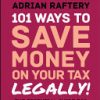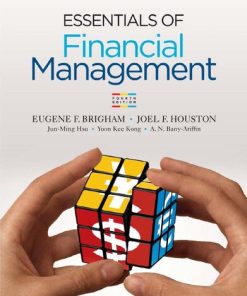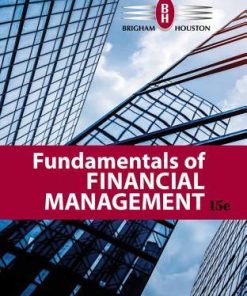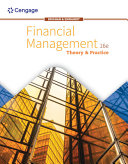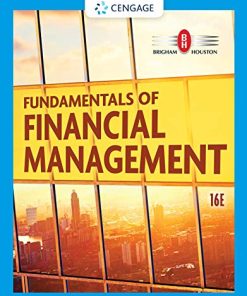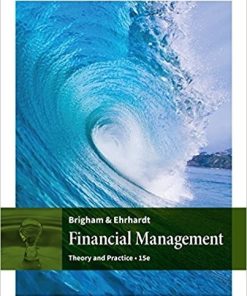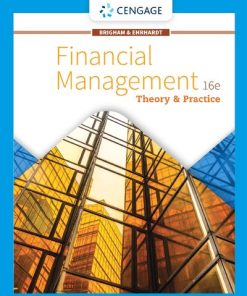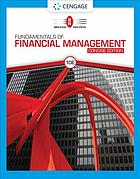Financial Management Theory and Practice 15th Edition by Eugene Brigham 8214343679 9798214343679
$50.00 Original price was: $50.00.$25.00Current price is: $25.00.
Financial Management: Theory & Practice 15th Edition by Eugene F. Brigham – Ebook PDF Instant Download/DeliveryISBN: 8214343679, 9798214343679
Full download Financial Management: Theory & Practice 15th Edition after payment.
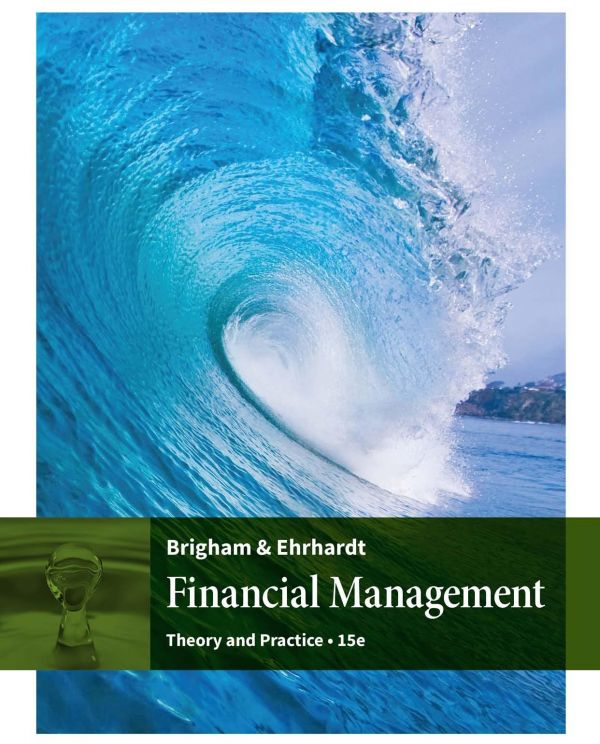
Product details:
ISBN-10 : 8214343679
ISBN-13 : 9798214343679
Author: Eugene F. Brigham
The only text that strikes a balance between solid financial theory and practical applications, Brigham/Ehrhardt’s FINANCIAL MANAGEMENT: THEORY AND PRACTICE, 15e equips your students with a thorough understanding of the essential concepts they need to develop and implement effective financial strategies. The book begins with a presentation of corporate finance fundamentals before progressing to discussions of specific techniques used to maximize the value of a firm. It also explores the recent financial and economic crises and the role of finance in the business world and in your students’ personal lives. With its relevant and engaging presentation, numerous examples, and emphasis on Excel usage, this text is the ideal choice for an introductory MBA course and serves as a complete reference tool for your students throughout their academic and business careers.
Financial Management: Theory & Practice 15th Table of contents:
Part 1. The Company and Its Environment
Chapter 1. An Overview of Financial Management and the Financial Environment
1-1. The Five-Minute MBA
1-2. Finance from 40,000 Feet Above
1-3. The Corporate Life Cycle
1-3a. Starting Up as a Proprietorship
1-3b. More Than One Owner: A Partnership
1-3c. Many Owners: A Corporation
1-3d. Growing a Corporation: Going Public
1-3e. Managing a Corporation’s Value
1-4. Governing a Corporation
1-4a. The Primary Objective of a Corporation: Maximizing Stockholder Wealth
1-4b. Intrinsic Stock Value Maximization and Social Welfare
1-4c. Ethics and Intrinsic Stock Value Maximization
1-5. An Overview of Financial Markets
1-5a. The Net Providers and Users of Capital
1-5b. Getting Cash from Providers to Users: The Capital Allocation Process
1-6. Claims on Future Cash Flows: Types of Financial Securities
1-6a. Type of Claim on Future Cash Flows: Debt, Equity, or Derivatives
1-6b. Type of Claim on Future Cash Flows: Securitized Financial Assets
1-7. Claims on Future Cash Flows: The Required Rate of Return (The Cost of Money)
1-7a. Fundamental Factors That Affect the Required Rate of Return (The Cost of Money)
1-7b. Economic Conditions and Policies That Affect the Required Rate of Return (The Cost of Money)
1-8. The Functions of Financial Institutions
1-8a. Investment Banks and Brokerage Activities
1-8b. Deposit-Taking Financial Intermediaries
1-8c. Investment Funds
1-8d. Life Insurance Companies and Pension Funds
1-8e. Regulation of Financial Institutions
1-9. Financial Markets
1-9a. Types of Financial Markets
1-9b. Why Are Secondary Markets Important?
1-9c. Trading Procedures in the Secondary Markets
1-10. Overview of the U.S. Stock Markets
1-11. Trading in the Modern Stock Markets
1-11a. Reg NMS: Stock Transactions, Quotes, and the “Market Price”
1-11b. Where Is Stock Traded?
1-11c. High-Frequency Trading (HFT)
1-11d. Stock Market Returns
1-12. Finance and the Great Recession of 2007
1-12a. The Globalization of Mortgage Market Securitization
1-12b. The Dark Side of Securitization: The Sub-Prime Mortgage Meltdown
1-12c. From Sub-Prime Meltdown to Liquidity Crisis to Economic Crisis
1-12d. Responding to the Economic Crisis
1-12e. Preventing the Next Crisis
1-13. The Big Picture
e-Resources
Summary
Questions
Mini Case
Chapter 2. Financial Statements, Cash Flow, and Taxes
2-1. Financial Statements and Reports
2-2. The Balance Sheet
2-2a. Assets
2-2b. Liabilities and Equity
2-3. The Income Statement
2-4. Statement of Stockholders’ Equity
2-5. Statement of Cash Flows
2-5a. Operating Activities
2-5b. Investing Activities
2-5c. Financing Activities
2-5d. Putting the Pieces Together
2-6. Net Cash Flow
2-7. Free Cash Flow: The Cash Flow Available for Distribution to Investors
2-7a. Net Operating Profit after Taxes (NOPAT)
2-7b. Net Operating Working Capital
2-7c. Total Net Operating Capital
2-7d. Net Investment in Operating Capital
2-7e. Calculating Free Cash Flow
2-7f. The Uses of FCF
2-7g. FCF and Corporate Value
2-8. Performance Evaluation
2-8a. The Return on Invested Capital
2-8b. Market Value Added (MVA)
2-8c. Economic Value Added (EVA)
2-8d. Intrinsic Value, MVA, and EVA
2-9. The Federal Income Tax System
2-9a. Corporate Income Taxes
2-9b. Taxation of Small Businesses: S Corporations
2-9c. Personal Taxes
Summary
Questions
Self-Test Problem
Problems
Spreadsheet Problems
Mini Case
Chapter 3. Analysis of Financial Statements
3-1. Financial Analysis
3-1a. Gather Data
3-1b. Examine the Statement of Cash Flows
3-1c. Calculate and Examine the Return on Invested Capital and Free Cash Flow
3-1d. Begin Ratio Analysis
3-2. Liquidity Ratios
3-2a. The Current Ratio
3-2b. The Quick Ratio
3-3. Asset Management Ratios
3-3a. Evaluating Total Assets: The Total Assets Turnover Ratio
3-3b. Evaluating Fixed Assets: The Fixed Assets Turnover Ratio
3-3c. Evaluating Receivables: The Days Sales Outstanding
3-3d. Evaluating Inventories: The Inventory Turnover Ratio
3-4. Debt Management Ratios
3-4a. How the Firm Is Financed: Leverage Ratios
3-4b. Ability to Pay Interest: Times-Interest-Earned Ratio
3-4c. Ability to Service Debt: EBITDA Coverage Ratio
3-5. Profitability Ratios
3-5a. Net Profit Margin
3-5b. Basic Earning Power (BEP) Ratio
3-5c. Return on Total Assets
3-5d. Return on Common Equity
3-6. Market Value Ratios
3-6a. Price/Earnings Ratio
3-6b. Price/Cash Flow Ratio
3-6c. Market/Book Ratio
3-7. Trend Analysis, Common Size Analysis, and Percentage Change Analysis
3-8. Tying the Ratios Together: The DuPont Equation
3-9. Comparative Ratios and Benchmarking
3-10. Uses and Limitations of Ratio Analysis
3-11. Looking Beyond the Numbers
Summary
Questions
Self-Test Problems
Problems
Spreadsheet Problem
Mini Case
Selected Additional Cases
Part 2. Fixed Income Securities
Chapter 4. Time Value of Money
4-1. Time Lines
4-2. Future Values
4-2a. Step-by-Step Approach
4-2b. Formula Approach
4-2c. Financial Calculators
4-2d. Spreadsheets
4-2e. Comparing the Procedures
4-2f. Graphic View of the Compounding Process
4-2g. Simple Interest versus Compound Interest
4-3. Present Values
4-3a. Discounting a Future Value to Find the Present Value
4-3b. Graphic View of the Discounting Process
4-4. Finding the Interest Rate, I
4-5. Finding the Number of Years, N
4-6. Perpetuities
4-7. Annuities
4-8. Future Value of an Ordinary Annuity
4-9. Future Value of an Annuity Due
4-10. Present Value of Ordinary Annuities and Annuities Due
4-10a. Present Value of an Ordinary Annuity
4-10b. Present Value of Annuities Due
4-11. Finding Annuity Payments, Periods, and Interest Rates
4-11a. Finding Annuity Payments, PMT
4-11b. Finding the Number of Periods, N
4-11c. Finding the Interest Rate, I
4-12. Uneven, or Irregular, Cash Flows
4-12a. Annuity Plus Additional Final Payment
4-12b. Irregular Cash Flow Stream
4-13. Future Value of an Uneven Cash Flow Stream
4-14. Solving for I with Irregular Cash Flows
4-15. Semiannual and Other Compounding Periods
4-15a. Types of Interest Rates
4-15b. The Result of Frequent Compounding
4-16. Fractional Time Periods
4-17. Amortized Loans
4-17a. Payments
4-17b. Amortization Schedules
4-17c. Mortgage Interest Payments
4-18. Growing Annuities
4-18a. Example 1: Finding a Constant Real Income
4-18b. Example 2: Initial Deposit to Accumulate a Future Sum
Summary
Questions
Self-Test Problems
Problems
Spreadsheet Problem
Mini Case
Chapter 5. Bonds, Bond Valuation, and Interest Rates
5-1. Who Issues Bonds?
5-2. Key Characteristics of Bonds
5-2a. Par Value
5-2b. Coupon Interest Rate
5-2c. Maturity Date
5-2d. Provisions to Call or Redeem Bonds
5-2e. Sinking Funds
5-2f. Other Provisions and Features
5-2g. Bond Markets
5-3. Bond Valuation
5-3a. Time Line, Cash Flows, and Valuation Formulas for a Bond
5-3b. Solving for the Bond Price
5-3c. Interest Rate Changes and Bond Prices
5-4. Changes in Bond Values Over Time
5-5. Bonds with Semiannual Coupons
5-6. Bond Yields
5-6a. Yield to Maturity
5-6b. Yield to Call
5-6c. Current Yield
5-6d. The Cost of Debt and Intrinsic Value
5-7. The Pre-Tax Cost of Debt: Determinants of Market Interest Rates
5-8. The Risk-Free Interest Rate: Nominal ( r RF ) and Real ( r * )
5-9. The Inflation Premium (IP)
5-10. The Maturity Risk Premium (MRP)
5-10a. Interest Rate Risk
5-10b. Reinvestment Rate Risk
5-10c. Comparing Interest Rate Risk and Reinvestment Rate Risk: The Maturity Risk Premium
5-11. The Default Risk Premium (DRP)
5-11a. Bond Contract Provisions That Influence Default Risk
5-11b. Bond Ratings
5-11c. Bond Rating Criteria, Upgrades, and Downgrades
5-11d. Bond Ratings and the Default Risk Premium
5-12. The Liquidity Premium (LP)
5-13. The Term Structure of Interest Rates
5-14. Financing with Junk Bonds
5-15. Bankruptcy and Reorganization
Summary
Questions
Self-Test Problem
Problems
Spreadsheet Problem
Mini Case
Selected Additional Cases
Part 3. Stocks and Options
Chapter 6. Risk and Return
6-1. Investment Returns and Risk
6-1a. Returns on Investments
6-1b. Stand-Alone Risk versus Portfolio Risk
6-2. Measuring Risk for Discrete Distributions
6-2a. Probability Distributions for Discrete Outcomes
6-2b. Expected Rate of Return for Discrete Distributions
6-2c. Measuring Stand-Alone Risk: The Standard Deviation of a Discrete Distribution
6-3. Risk in a Continuous Distribution
6-4. Using Historical Data to Estimate Risk
6-4a. Calculating the Historical Average and Standard Deviation
6-4b. Calculating MicroDrive’s Historical Average and Standard Deviation
6-5. Risk in a Portfolio Context
6-5a. Creating a Portfolio
6-5b. Correlation and Risk for a Two-Stock Portfolio
6-5c. Diversification and Multi-Stock Portfolios
6-6. The Relevant Risk of a Stock: The Capital Asset Pricing Model (CAPM)
6-6a. Contribution to Market Risk: Beta
6-6b. Estimating Beta
6-6c. Interpreting the Estimated Beta
6-7. The Relationship between Risk and Return in the Capital Asset Pricing Model
6-7a. The Security Market Line (SML)
6-7b. The Impact on Required Return Due to Changes in the Risk-Free Rate, Risk Aversion, and Beta
6-7c. Portfolio Returns and Portfolio Performance Evaluation
6-7d. Required Returns versus Expected Returns: Market Equilibrium
6-8. The Efficient Markets Hypothesis
6-8a. Forms of the Efficient Markets Hypothesis
6-8b. Is the Stock Market Efficient? The Empirical Evidence
6-9. The Fama-French Three-Factor Model
6-10. Behavioral Finance
6-10a. Market Bubbles and Behavioral Finance
6-10b. Other Applications of Behavioral Finance
6-11. The CAPM and Market Efficiency: Implications for Corporate Managers and Investors
Summary
Questions
Self-Test Problems
Problems
Spreadsheet Problems
Mini Case
Selected Additional Cases
Chapter 7. Corporate Valuation and Stock Valuation
7-1. Legal Rights and Privileges of Common Stockholders
7-1a. Control of the Firm
7-1b. The Preemptive Right
7-2. Types of Common Stock
7-3. Stock Market Reporting
7-4. Valuing Common Stocks—Introducing the Free Cash Flow (FCF) Valuation Model
7-4a. Sources of Value and Claims on Value
7-4b. The Intrinsic Value per Share of Common Stock
7-5. The Constant Growth Model: Valuation When Expected Free Cash Flow Grows at a Constant Rate
7-5a. Estimating the Value of Operations when Expected Growth Is Constant
7-5b. How to Avoid Common Mistakes when Applying the Constant Growth Model
7-6. The Multistage Model: Valuation when Expected Short-Term Free Cash Flow Grows at a Nonconstant Rate
7-6a. The Forecast Period and the Horizon Value
7-6b. The Current Value of Operations
7-7. Application of the FCF Valuation Model to MicroDrive
7-7a. Forecasting MicroDrive’s Free Cash Flows
7-7b. MicroDrive’s Horizon Value
7-7c. MicroDrive’s Current Value of Operations
7-7d. MicroDrive’s Intrinsic Value per Share of Common Stock
7-8. Do Stock Values Reflect Long-Term or Short-Term Cash Flows?
7-9. Value-Based Management: Using the Free Cash Flow Valuation Model to Identify Value Drivers
7-10. Why Are Stock Prices So Volatile?
7-11. Valuing Common Stocks with the Dividend Growth Model
7-11a. Definitions of Terms Used in Stock Valuation Models
7-11b. Expected Dividends as the Basis for Stock Values
7-11c. Valuing a Constant Growth Stock
7-11d. Valuing Nonconstant Growth Stocks
7-12. The Market Multiple Method
7-13. Comparing the FCF Valuation Model, the Dividend Growth Model, and the Market Multiple Method
7-14. Preferred Stock
Summary
Questions
Self-Test Problems
Problems
Spreadsheet Problems
Mini Case
Selected Additional Cases
Chapter 8. Financial Options and Applications in Corporate Finance
8-1. Overview of Financial Options
8-2. The Single-Period Binomial Option Pricing Approach
8-2a. Payoffs in a Single-Period Binomial Model
8-2b. The Hedge Portfolio Approach
8-2c. Hedge Portfolios and Replicating Portfolios
8-3. The Single-Period Binomial Option Pricing Formula
8-3a. The Binomial Option Pricing Formula
8-3b. Primitive Securities and the Binomial Option Pricing Formula
8-4. The Multi-Period Binomial Option Pricing Model
8-5. The Black-Scholes Option Pricing Model (OPM)
8-5a. OPM Assumptions and Results
8-5b. Application of the Black-Scholes Option Pricing Model to a Call Option
8-5c. The Five Factors That Affect Call Option Prices
8-6. The Valuation of Put Options
8-6a. Put-Call Parity
8-6b. The Five Factors That Affect Put Option Prices
8-7. Applications of Option Pricing in Corporate Finance
8-7a. Real Options
8-7b. Risk Management
8-7c. Capital Structure Decisions
8-7d. Compensation Plans
Summary
Questions
Self-Test Problems
Problems
Spreadsheet Problem
Mini Case
Part 4. Projects and Their Valuation
Chapter 9. The Cost of Capital
9-1. The Weighted Average Cost of Capital
9-2. Choosing Weights for the Weighted Average Cost of Capital
9-3. After-Tax Cost of Debt: r d ( 1 – T ) and r std ( 1 – T )
9-3a. The Before-Tax Cost of Short-Term Debt: r std
9-3b. The Before-Tax Cost of Long-Term Debt: r d
9-3c. The After-Tax Cost of Debt: r d ( 1 – T ) and r std ( 1 – T )
9-3d. Flotation Costs and the Cost of Debt
9-4. Cost of Preferred Stock, r ps
9-5. Cost of Common Stock: The Market Risk Premium, RP M
9-5a. Historical Risk Premium
9-5b. Surveys of Experts
9-5c. Forward-Looking Risk Premiums
9-5d. Our View on the Market Risk Premium
9-6. Using the CAPM to Estimate the Cost of Common Stock, r s
9-6a. The Capital Asset Pricing Model
9-6b. Estimating the Risk-Free Rate, r RF
9-6c. Estimating the Market Risk Premium, RP M
9-6d. Estimating Beta, b i
9-6e. An Illustration of the CAPM Approach: MicroDrive’s Cost of Equity, r s
9-7. Using the Dividend Growth Approach to Estimate the Cost of Common Stock
9-7a. Estimating Inputs for the Dividend Growth Approach
9-7b. An Illustration of the Dividend Growth Approach
9-8. The Weighted Average Cost of Capital (WACC)
9-8a. Marginal Rates versus Historical Rates
9-8b. Target Weights versus Annual Financing Choices
9-8c. Weights for Component Costs: Book Values versus Market Values versus Targets
9-9. Adjusting the Cost of Equity for Flotation Costs
9-10. Privately Owned Firms and Small Businesses
9-10a. Estimating the Cost of Stock by the Comparison Approach
9-10b. Own-Bond-Yield-Plus-Judgmental-Risk-Premium Approach
9-10c. Adjusting for Lack of Liquidity
9-10d. Estimating the Actual Weights in a Privately Owned Company’s Capital Structure
9-11. The Divisional Cost of Capital
9-11a. Using the CAPM to Estimate Divisional Costs of Capital
9-11b. Techniques for Measuring Divisional Betas
9-12. Estimating the Cost of Capital for Individual Projects
9-13. Managerial Issues and the Cost of Capital
9-13a. How Managerial Decisions Affect the Cost of Capital
9-13b. Four Mistakes to Avoid
Summary
Questions
Self-Test Problem
Problems
Spreadsheet Problem
Mini Case
Selected Additional Cases
Chapter 10. The Basics of Capital Budgeting: Evaluating Cash Flows
10-1. An Overview of Capital Budgeting
10-2. The First Step in Project Analysis
10-3. Net Present Value (NPV)
10-3a. Calculating NPV
10-3b. Applying NPV as an Evaluation Measure
10-4. Internal Rate of Return (IRR)
10-4a. Calculating the IRR
10-4b. A Potential Problem with the IRR: Multiple Internal Rates of Return
10-4c. Potential Problems When Using the IRR to Evaluate Mutually Exclusive Projects
10-4d. Applying IRR as an Evaluation Measure
10-5. Modified Internal Rate of Return (MIRR)
10-6. Profitability Index (PI)
10-7. Payback Period
10-8. How to Use the Different Capital Budgeting Methods
10-8a. A Comparison of the Methods
10-8b. The Decision Process: What Is the Source of a Project’s NPV?
10-8c. Decision Criteria Used in Practice
10-9. Other Issues in Capital Budgeting
10-9a. Mutually Exclusive Projects with Unequal Lives
10-9b. Economic Life versus Physical Life
10-9c. The Optimal Capital Budget
Summary
Questions
Self-Test Problem
Problems
Spreadsheet Problem
Mini Case
Selected Additional Cases
Chapter 11. Cash Flow Estimation and Risk Analysis
11-1. Identifying Relevant Cash Flows
11-1a. Cash Flow versus Accounting Income
11-1b. Timing of Cash Flows: Yearly versus Other Periods
11-1c. Expansion Projects and Replacement Projects
11-1d. Sunk Costs
11-1e. Opportunity Costs Associated with Assets the Firm Already Owns
11-1f. Externalities
11-2. Analysis of an Expansion Project
11-2a. Base Case Inputs and Key Results
11-2b. Cash Flow Projections: Intermediate Calculations
11-2c. Cash Flow Projections: Estimating Net Operating Profit after Taxes (NOPAT)
11-2d. Cash Flow Projections: Adjustments to NOPAT
11-2e. Evaluating Project Cash Flows
11-3. Risk Analysis in Capital Budgeting
11-4. Measuring Stand-Alone Risk
11-5. Sensitivity Analysis
11-5a. Sensitivity Graph
11-5b. Tornado Diagrams
11-5c. NPV Break-Even Analysis
11-5d. Extensions of Sensitivity Analysis
11-6. Scenario Analysis
11-7. Monte Carlo Simulation
11-8. Project Risk Conclusions
11-9. Replacement Analysis
11-10. Real Options
11-10a. Investment Timing Options
11-10b. Growth Options
11-10c. Abandonment Options
11-10d. Flexibility Options
11-10e. Valuing Real Options
11-11. Phased Decisions and Decision Trees
11-11a. The Basic Decision Tree
11-11b. Staged Decision Tree
Summary
Questions
Self-Test Problems
Problems
Spreadsheet Problem
Mini Case
Selected Additional Cases
Appendix 11A. Tax Depreciation
Part 5. Corporate Valuation and Governance
Chapter 12. Corporate Valuation and Financial Planning
12-1. Overview of Financial Planning
12-1a. The Operating Plan
12-1b. The Financial Plan
12-2. Financial Planning at MicroDrive, Inc.
12-3. Forecasting Operations
12-3a. Sales Revenues
12-3b. Operating Assets
12-3c. Operating Liabilities
12-3d. Operating Income
12-3e. Free Cash Flow (FCF)
12-3f. Estimated Intrinsic Value
12-3g. Enhancements to the Basic Model
12-4. Evaluating MicroDrive’s Strategic Initiatives
12-5. Projecting MicroDrive’s Financial Statements
12-5a. Forecast the Accounts from the Operating Plan
12-5b. Forecast Items Determined by the Preliminary Short-Term Financial Policy
12-5c. Identify and Eliminate the Financing Deficit or Surplus in the Projected Balance Sheets
12-6. Analysis and Selection of a Strategic Plan
12-7. The CFO’s Model
12-7a. Financing Feedback
12-7b. Implementing the Target Capital Structure
12-8. Additional Funds Needed (AFN) Equation Method
12-8a. Required Increase in Assets
12-8b. Spontaneous Liabilities
12-8c. Addition to Retained Earnings
12-8d. Calculating Additional Funds Needed (AFN)
12-8e. Using MicroDrive’s Data to Implement the AFN Equation Method
12-8f. Key Factors in the AFN Equation
12-8g. The Self-Supporting Growth Rate
12-9. Forecasting When the Ratios Change
12-9a. Economies of Scale
12-9b. Nonlinear Relationships
12-9c. Lumpy Assets and Excess Capacity
Summary
Questions
Self-Test Problems
Problems
Spreadsheet Problems
Mini Case
Selected Additional Cases
Chapter 13. Corporate Governance
13-1. Agency Conflicts
13-1a. Conflicts between Stockholders and Creditors
13-1b. Conflicts between Inside Owner/Managers and Outside Owners
13-1c. Conflicts between Managers and Shareholders
13-2. Corporate Governance
13-2a. Monitoring and Discipline by the Board of Directors
13-2b. Charter Provisions and Bylaws That Affect the Likelihood of Hostile Takeovers
13-2c. Using Compensation to Align Managerial and Shareholder Interests
13-2d. Capital Structure and Internal Control Systems
13-2e. Environmental Factors Outside a Firm’s Control
13-3. Employee Stock Ownership Plans (ESOPs)
Summary
Questions
Mini Case
Part 6. Cash Distributions and Capital Structure
Chapter 14. Distributions to Shareholders: Dividends and Repurchases
14-1. An Overview of Cash Distributions
14-1a. Sources of Cash
14-1b. Uses of Cash
14-2. Procedures for Cash Distributions
14-2a. Dividend Payment Procedures
14-2b. Stock Repurchase Procedures
14-2c. Patterns of Cash Distributions
14-3. Cash Distributions and Firm Value
14-3a. Dividend Irrelevance Theory
14-3b. Dividend Preference (Bird-in-the-Hand) Theory
14-3c. Tax Effect Theory: Capital Gains Are Preferred
14-3d. Empirical Evidence on Distribution Policies
14-4. Clientele Effect
14-5. Signaling Hypothesis
14-6. Implications for Dividend Stability
14-7. Setting the Target Distribution Level: The Residual Distribution Model
14-8. The Residual Distribution Model in Practice
14-9. A Tale of Two Cash Distributions: Dividends versus Stock Repurchases
14-9a. The Impact on Financial Statements
14-9b. The Residual Distribution Model: Application to Full Financial Statements
14-9c. The Impact of Distributions on Intrinsic Value
14-10. The Pros and Cons of Dividends and Repurchases
14-11. Other Factors Influencing Distributions
14-11a. Constraints
14-11b. Alternative Sources of Capital
14-12. Summarizing the Distribution Policy Decision
14-13. Stock Splits and Stock Dividends
14-13a. Stock Splits
14-13b. Stock Dividends
14-13c. Effect on Stock Prices
14-14. Dividend Reinvestment Plans
Summary
Questions
Self-Test Problems
Problems
Spreadsheet Problem
Mini Case
Selected Additional Cases
Chapter 15. Capital Structure Decisions
15-1. An Overview of Capital Structure
15-2. Business Risk and Financial Risk
15-2a. Business Risk and Operating Leverage
15-2b. Financial Risk and Financial Leverage
15-3. Capital Structure Theory: The Modigliani and Miller Models
15-3a. Modigliani and Miller: No Taxes
15-3b. Modigliani and Miller: The Effect of Corporate Taxes
15-3c. Miller: The Effect of Corporate and Personal Taxes
15-4. Capital Structure Theory: Beyond the Modigliani and Miller Models
15-4a. Trade-Off Theory
15-4b. Signaling Theory
15-4c. Reserve Borrowing Capacity
15-4d. The Pecking Order Hypothesis
15-4e. Using Debt Financing to Constrain Managers
15-4f. The Investment Opportunity Set and Reserve Borrowing Capacity
15-4g. The Market Timing Theory
15-5. Capital Structure Evidence and Implications
15-5a. Empirical Evidence
15-5b. Implications for Managers
15-6. Estimating the Optimal Capital Structure
15-6a. Strasburg’s Current Value and Capital Structure
15-6b. Estimating the Weighted Average Cost of Capital (WACC) for Different Levels of Debt
15-6c. Estimating the Firm’s Value
15-7. Anatomy of a Recapitalization
15-7a. Strasburg Issues New Debt but Has Not Yet Repurchased Stock
15-7b. Strasburg Repurchases Stock
15-7c. Recapitalization: A Post-Mortem
15-8. Risky Debt and Equity as an Option
15-8a. Using the Black-Scholes Option Pricing Model to Value Equity
15-8b. Managerial Risk Incentives
15-9. Managing the Maturity Structure of Debt
15-9a. Maturity Matching
15-9b. Effects of Interest Rate Levels and Forecasts
15-9c. Information Asymmetries
15-9d. Amount of Financing Required
15-9e. Availability of Collateral
15-9f. Evidence on Debt Maturity in Practice
Summary
Questions
Self-Test Problems
Problems
Spreadsheet Problems
Mini Case
Selected Additional Cases
Part 7. Managing Global Operations
Chapter 16. Supply Chains and Working Capital Management
16-1. Overview of Supply Chain Management
16-2. Using and Financing Operating Current Assets
16-2a. Efficient Investment in Operating Current Assets
16-2b. Financing Operating Current Assets
16-3. The Cash Conversion Cycle
16-3a. Calculating the Target CCC
16-3b. Calculating the Actual Cash Conversion Cycle from Financial Statements
16-3c. Benefits of Reducing the Cash Conversion Cycle
16-4. Inventory Management
16-5. Receivables Management
16-5a. Credit Policy
16-5b. Credit Policy and the Accumulation of Receivables
16-5c. Monitoring the Receivables Position
16-6. Accruals and Accounts Payable (Trade Credit)
16-6a. Accruals
16-6b. Accounts Payable (Trade Credit)
16-6c. The Cost of Trade Credit
16-7. The Cash Budget
16-7a. Monthly Cash Budgets
16-7b. Cash Budgets versus Income Statements and Free Cash Flows
16-7c. Daily Cash Budgets
16-8. Cash Management and the Target Cash Balance
16-8a. Routine (but Uncertain) Operating Transactions
16-8b. Compensating Balances
16-9. Cash Management Techniques
16-9a. Payment, Clearing, and Settlement Systems
16-9b. Synchronizing Cash Flow
16-9c. Using Float
16-9d. Speeding Up Collections
16-10. Managing Short-Term Investments
16-11. Short-Term Financing
16-11a. Advantages of Short-Term Financing
16-11b. Disadvantages of Short-Term Debt
16-12. Short-Term Bank Loans
16-12a. Maturity
16-12b. Promissory Notes
16-12c. Compensating Balances
16-12d. Informal Line of Credit
16-12e. Revolving Credit Agreement
16-12f. Costs of Bank Loans
16-13. Commercial Paper
16-13a. Maturity and Cost
16-13b. Use of Commercial Paper
16-14. Use of Security in Short-Term Financing
Summary
Questions
Self-Test Problems
Problems
Spreadsheet Problem
Mini Case
Selected Additional Cases
Chapter 17. Multinational Financial Management
17-1. Multinational, or Global, Corporations
17-2. Multinational versus Domestic Financial Management
17-3. Exchange Rates
17-3a. Foreign Exchange Notation
17-3b. Converting Currencies
17-4. Exchange Rates and International Trade
17-5. The International Monetary System and Exchange Rate Policies
17-5a. A Short History Lesson: The Bretton Woods Fixed Exchange Rate System
17-5b. Floating Exchange Rates
17-5c. Pegged Exchange Rates
17-5d. Managed Floating Rates
17-5e. No Local Currency
17-6. Trading in Foreign Exchange
17-6a. Spot Rates and Forward Rates
17-7. Interest Rate Parity
17-8. Purchasing Power Parity
17-9. Inflation, Interest Rates, and Exchange Rates
17-10. International Money and Capital Markets
17-10a. Eurodollar Market
17-10b. International Bond Markets
17-10c. International Stock Markets
17-10d. Sovereign Debt
17-11. Multinational Capital Budgeting
17-11a. Risk Exposure
17-11b. Cash Flow Estimation
17-11c. Project Analysis
17-12. International Capital Structures
17-13. Multinational Working Capital Management
17-13a. Cash Management
17-13b. Credit Management
17-13c. Inventory Management
Summary
Questions
Self-Test Problem
Problems
Spreadsheet Problem
Mini Case
Selected Additional Case
Part 8. Tactical Financing Decisions
Chapter 18. Public and Private Financing: Initial Offerings, Seasoned Offerings, and Investment Banks
18-1. The Financial Life Cycle of a Start-Up Company
18-2. The Decision to Go Public
18-2a. Advantages of Going Public
18-2b. Disadvantages of Going Public
18-3. The Process of Going Public: An Initial Public Offering
18-3a. Selecting an Investment Bank
18-3b. The Underwriting Syndicate
18-3c. Regulation of Securities Sales
18-3d. The Roadshow and Book-Building
18-3e. Setting the Offer Price
18-3f. The First Day of Trading
18-3g. The Costs of Going Public
18-3h. The Importance of the Secondary Market
18-3i. Regulating the Secondary Market
18-3j. Questionable IPO Practices
18-4. Equity Carve-Outs: A Special Type of IPO
18-5. Other Ways to Raise Funds in the Capital Markets
18-5a. Preliminary Decisions
18-5b. Seasoned Equity Offerings
18-5c. Shelf Registrations
18-5d. Private Placements
18-5e. Securitization
18-6. Investment Banking Activities
18-6a. Mergers and Acquisitions
18-6b. Securitization
18-6c. Asset Management
18-6d. Trading Operations
18-7. The Decision to Go Private
18-8. Refunding Operations
18-8a. Analysis of Microchip’s Refunding Operation
18-8b. Steps in a Refunding Analysis
18-8c. Refund Now or Later?
18-9. Managing the Risk Structure of Debt with Project Financing
Summary
Questions
Self-Test Problems
Problems
Spreadsheet Problem
Mini Case
Selected Additional Cases
Chapter 19. Lease Financing
19-1. Types of Leases
19-1a. Operating Leases
19-1b. Financial, or Capital, Leases
19-1c. Sale-and-Leaseback Arrangements
19-1d. Combination Leases
19-1e. Synthetic Leases
19-2. Tax Effects
19-3. Financial Statement Effects
19-4. Evaluation by the Lessee
19-5. Evaluation by the Lessor
19-5a. Analysis by the Lessor
19-5b. Setting the Lease Payment
19-6. Other Issues in Lease Analysis
19-6a. Estimated Residual Value
19-6b. Increased Credit Availability
19-6c. Real Estate Leases
19-6d. Vehicle Leases
19-6e. Leasing and Tax Laws
19-7. Other Reasons for Leasing
Summary
Questions
Self-Test Problem
Problems
Spreadsheet Problem
Mini Case
Selected Additional Cases
Chapter 20. Hybrid Financing: Preferred Stock, Warrants, and Convertibles
20-1. Preferred Stock
20-1a. Basic Features
20-1b. Other Types of Preferred Stock
20-1c. Advantages and Disadvantages of Preferred Stock
20-2. Warrants
20-2a. Initial Market Price of a Bond with Warrants
20-2b. Use of Warrants in Financing
20-2c. The Component Cost of Bonds with Warrants
20-3. Convertible Securities
20-3a. Conversion Ratio and Conversion Price
20-3b. The Component Cost of Convertibles
20-3c. Use of Convertibles in Financing
20-3d. Convertibles and Agency Costs
20-4. A Final Comparison of Warrants and Convertibles
20-5. Reporting Earnings When Warrants or Convertibles Are Outstanding
Summary
Questions
Self-Test Problem
Problems
Spreadsheet Problem
Mini Case
Selected Additional Cases
Part 9. Strategic Finance in a Dynamic Environment
Chapter 21. Dynamic Capital Structures and Corporate Valuation
21-1. The Adjusted Present Value (APV) Approach
21-1a. The Value of a Levered Firm ( V L )
21-1b. The Levered Cost of Equity ( r sL )
21-1c. The Levered Beta (b)
21-1d. The Tax Shield Discount Rate ( r TS )
21-2. The Modigliani and Miller Models
21-2a. Modigliani and Miller: No Taxes
21-2b. Modigliani and Miller: Corporate Taxes
21-3. The Compressed Adjusted Present Value (CAPV) Model
21-4. Multistage Valuation When the Capital Structure Is Stable
21-4a. A Brief Review of the Multistage FCF Corporate Valuation Model
21-4b. The Multistage Free Cash Flow to Equity (FCFE) Approach
21-4c. The Multistage Compressed APV Approach
21-5. Illustration of the Three Valuation Approaches for a Constant Capital Structure
21-5a. Cash Flow Projections
21-5b. Valuation Using the Corporate FCF Valuation Model
21-5c. Valuation Using the APV Approach
21-5d. Valuation Using the FCFE Model
21-6. Analysis of a Dynamic Capital Structure
21-6a. The Dynamic Capital Structure’s Effect on the Tax Shield
21-6b. The Dynamic Capital Structure’s Effect on Value
Summary
Questions
Self-Test Problem
Problems
Spreadsheet Problem
Mini Case
Selected Additional Cases
Chapter 22. Mergers and Corporate Control
22-1. Rationale for Mergers
22-1a. Synergy
22-1b. Tax Considerations
22-1c. Purchase of Assets below Their Replacement Cost
22-1d. Diversification
22-1e. Managers’ Personal Incentives
22-1f. Breakup Value
22-2. Types of Mergers
22-3. Level of Merger Activity
22-4. Hostile versus Friendly Takeovers
22-5. Merger Regulation
22-6. Overview of Merger Analysis
22-7. Estimating a Target’s Value
22-7a. Projecting Post-Merger Cash Flows
22-7b. Valuation Using the Compressed APV Approach
22-8. Setting the Bid Price
22-8a. Relative Bargaining Power
22-8b. Cash Offers versus Stock Offers
22-9. Analysis When the Capital Structure Changes during the Explicit Forecast Period
22-9a. The Effect on the Tax Shield
22-9b. The Effect on the Bid Price
22-10. Taxes and the Structure of the Takeover Bid
22-11. Financial Reporting for Mergers
22-11a. Purchase Accounting
22-11b. Income Statement Effects
22-12. Analysis for a “True Consolidation”
22-13. The Role of Investment Bankers
22-13a. Arranging Mergers
22-13b. Developing Defensive Tactics
22-13c. Establishing a Fair Value
22-13d. Financing Mergers
22-13e. Arbitrage Operations
22-14. Who Wins: The Empirical Evidence
22-15. Corporate Alliances
22-16. Divestitures
22-17. Holding Companies
22-17a. Advantages and Disadvantages of Holding Companies
22-17b. Holding Companies as a Leveraging Device
Summary
Questions
Self-Test Problem
Problems
Spreadsheet Problem
Mini Case
Selected Additional Cases
Chapter 23. Enterprise Risk Management
23-1. Reasons to Manage Risk
23-2. An Overview of Enterprise Risk Management
23-3. A Framework for Enterprise Risk Management
23-3a. The Committee of Sponsoring Organizations’ (COSO) Framework for Enterprise Risk Management (ERM)
23-3b. The Components of the COSO Enterprise Risk Management Framework
23-4. Categories of Risk Events
23-4a. Major Categories
23-4b. Dimensions of Risk
23-5. Foreign Exchange (FX) Risk
23-6. Commodity Price Risk
23-6a. An Overview of Futures Markets
23-6b. Using Futures Contracts to Reduce Commodity Price Exposure
23-6c. Options on Futures
23-7. Interest Rate Risk
23-7a. Using Futures Contracts to Manage the Risk of Debt Issuances
23-7b. Using Interest Rate Swaps: Managing Floating versus Fixed Rates
23-7c. Inverse Floaters
23-8. Project Selection Risks
23-8a. Using Monte Carlo Simulation to Evaluate Project Risk
23-8b. Using Monte Carlo Simulation to Evaluate Financing Risks
23-8c. Using Monte Carlo Simulation to Evaluate Portfolio Risks
23-9. Managing Credit Risks
23-9a. Managing Credit Risk at Nonfinancial Companies
23-9b. Managing Credit Risk at Financial Institutions
23-10. Risk and Human Safety
Summary
Questions
Self-Test Problem
Problems
Spreadsheet Problem
Mini Case
Chapter 24. Bankruptcy, Reorganization, and Liquidation
24-1. Financial Distress and Its Consequences
24-1a. Causes of Business Failure
24-1b. The Business Failure Record
24-2. Issues Facing a Firm in Financial Distress
24-3. Settlements without Going through Formal Bankruptcy
24-3a. Informal Reorganization
24-3b. Informal Liquidation
24-4. Federal Bankruptcy Law
24-5. Reorganization in Bankruptcy (Chapter 11 of Bankruptcy Code)
24-5a. Illustration of a Reorganization
24-5b. Prepackaged Bankruptcies
24-5c. Reorganization Time and Expense
24-6. Liquidation in Bankruptcy
24-7. Anatomy of a Bankruptcy: Transforming the GM Corporation into the GM Company
24-8. Other Motivations for Bankruptcy
24-9. Some Criticisms of Bankruptcy Laws
Summary
Questions
Self-Test Problem
Problems
Spreadsheet Problem
Mini Case
Selected Additional Cases
Part 10. Special Topics
Chapter 25. Portfolio Theory and Asset Pricing Models
25-1. Efficient Portfolios
25-1a. The Two-Asset Case
25-1b. The N-Asset Case
25-2. Choosing the Optimal Portfolio
25-2a. The Efficient Frontier
25-2b. Risk–Return Indifference Curves
25-2c. The Optimal Portfolio for an Investor
25-3. The Basic Assumptions of the Capital Asset Pricing Model
25-4. The Capital Market Line and the Security Market Line
25-5. Calculating Beta Coefficients
25-5a. Calculating the Beta Coefficient for a Single Stock: Apple
25-5b. The Market Model versus the CAPM
25-5c. Calculating the Beta Coefficient for a Portfolio: The Magellan Fund
25-5d. Performance Measures
25-5e. Additional Insights into Risk and Return
25-5f. Modifying the Historical Beta
25-5g. Choice of Estimation Period, Holding Period, and Market Index
25-6. Empirical Tests of the CAPM
25-6a. Tests of the Stability of Beta Coefficients
25-6b. Tests of the CAPM Based on the Slope of the SML
25-6c. Current Status of the CAPM
25-7. Arbitrage Pricing Theory
Summary
Questions
Self-Test Problem
Problems
Spreadsheet Problem
Mini Case
Selected Additional Case
Chapter 26. Real Options
26-1. Valuing Real Options
26-2. The Investment Timing Option: An Illustration
26-2a. Approach 1: DCF Analysis Ignoring the Timing Option
26-2b. Approach 2: DCF Analysis with a Qualitative Consideration of the Timing Option
26-2c. Approach 3: Scenario Analysis and Decision Trees
26-2d. Approach 4: Valuing the Timing Option with the Black-Scholes Option Pricing Model
26-2e. Approach 5: Financial Engineering
26-3. The Growth Option: An Illustration
26-3a. Approach 1: DCF Analysis Ignoring the Growth Option
26-3b. Approach 2: DCF Analysis with a Qualitative Consideration of the Growth Option
26-3c. Approach 3: Decision-Tree Analysis of the Growth Option
26-3d. Approach 4: Valuing the Growth Option with the Black-Scholes Option Pricing Model
26-4. Concluding Thoughts on Real Options
Summary
Questions
Self-Test Problem
Problems
Spreadsheet Problem
Mini Case
Chapter 27. Providing and Obtaining Credit
27-1. Credit Policy
27-2. Setting the Credit Period and Standards
27-2a. Credit Standards
27-3. Setting the Collection Policy
27-4. Cash Discounts
27-5. Other Factors Influencing Credit Policy
27-5a. Profit Potential
27-5b. Legal Considerations
27-6. Monitoring Receivables with the Uncollected Balances Schedule
27-7. Analyzing Proposed Changes in Credit Policy
27-8. Analyzing Proposed Changes in Credit Policy: Incremental Analysis
27-8a. The Basic Equations
27-8b. Changing the Credit Period
27-8c. Changes in Other Credit Policy Variables
27-8d. Simultaneous Changes in Policy Variables
27-9. The Cost of Bank Loans
27-9a. Regular, or Simple, Interest
27-9b. Discount Interest
27-9c. Effects of Compensating Balances
27-9d. Installment Loans: Add-On Interest
27-9e. Annual Percentage Rate
27-10. Choosing a Bank
27-10a. Willingness to Assume Risks
27-10b. Advice and Counsel
27-10c. Loyalty to Customers
27-10d. Specialization
27-10e. Maximum Loan Size
27-10f. Other Services
Summary
Questions
Problems
Spreadsheet Problem
Mini Case
Selected Additional Cases
Chapter 28. Advanced Issues in Cash Management and Inventory Control
28-1. The Concept of Zero Working Capital
28-2. Setting the Target Cash Balance
28-2a. The Baumol Model
28-2b. Monte Carlo Simulation
28-3. Inventory Control Systems
28-3a. Computerized Systems
28-3b. Just-in-Time Systems
28-3c. Outsourcing
28-3d. The Relationship between Production Scheduling and Inventory Levels
28-4. Accounting for Inventory
28-4a. Specific Identification
28-4b. First-In, First-Out (FIFO)
28-4c. Last-In, First-Out (LIFO)
28-4d. Weighted Average
28-4e. Comparison of Inventory Accounting Methods
28-5. The Economic Ordering Quantity (EOQ) Model
28-5a. Carrying Cost
28-5b. Ordering Cost
28-5c. Total Inventory Costs
28-5d. Derivation of the EOQ Model
28-5e. EOQ Model Illustration
28-5f. Setting the Order Point
28-6. EOQ Model Extensions
28-6a. The Concept of Safety Stocks
28-6b. Setting the Safety Stock Level
28-6c. Quantity Discounts
28-6d. Inflation
28-6e. Seasonal Demand
28-6f. EOQ Range
Summary
Questions
Problems
Spreadsheet Problem
Mini Case
Selected Additional Cases
Chapter 29. Pension Plan Management
29-1. The Role and Scope of Pension Plan Management
29-2. Types of Pension Plans and Key Features
29-2a. Defined Contribution Plan
29-2b. Defined Benefit Plan
29-2c. Profit Sharing Plan
29-2d. Cash Balance Plan
29-2e. Other Key Features
29-3. Pension Fund Regulation and Accounting
29-3a. The Pension Plan Funding Status
29-3b. Pension Regulation
29-3c. Financial Reporting
29-4. Pension Fund Mathematics: Defined Benefit Plans
29-5. Risks Inherent in Pension Plans
29-5a. Risks to the Corporation
29-5b. Risks to Beneficiaries
29-6. Illustration of a Defined Benefit versus a Defined Contribution Plan
29-6a. Company DB: Defined Benefit
29-6b. Company DC: Defined Contribution
29-6c. Conclusions
29-7. Defined Benefit versus Defined Contribution Plans: The Employee Choice
29-8. Developing a Plan Strategy
29-9. Pension Fund Investment Performance
29-9a. Active Workers vis-à-vis Retirees
29-9b. Performance Measurement
29-10. “Tapping” Pension Fund Assets
29-11. Retiree Health Benefits
Summary
Questions
Problems
Mini Case
Chapter 30. Financial Management in Not-for-Profit Businesses
30-1. For-Profit (Investor-Owned) versus Not-for-Profit Businesses
30-2. Goals of the Firm
30-3. Estimating the Cost of Capital
30-4. Capital Structure Decisions
30-5. Capital Budgeting Decisions
30-5a. The Goal of Project Analysis
30-5b. Cash Flow Estimation/Decision Methods
30-5c. Risk Analysis
30-6. Long-Term Financing Decisions
30-6a. Long-Term Debt Financing
30-6b. Equity (Fund) Financing
30-7. Financial Analysis, Planning, and Forecasting
People also search for Financial Management: Theory & Practice 15th:
public financial management system
objectives of financial management
functions of financial management
importance of financial management
define financial management
Tags: Financial Management, Theory, Practice, Eugene Brigham
You may also like…
Business & Economics - Professional Finance
Business & Economics - Professional Finance
Fundamentals of Financial Management 15th Edition Eugene F. Brigham
Business & Economics - Professional Finance
Business & Economics - Professional Finance
Fundamentals of Financial Management 16th Edition Eugene F. Brigham
Business & Economics - Personal Finance
Business & Economics - Professional Finance



